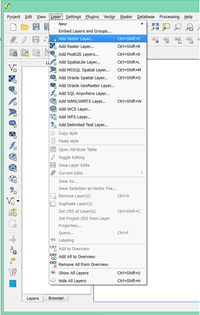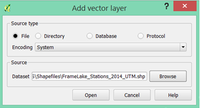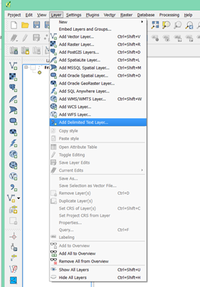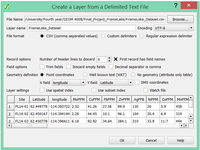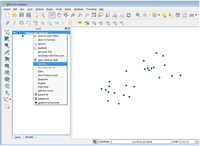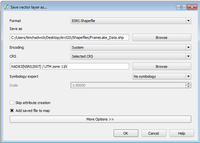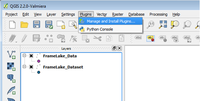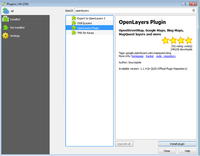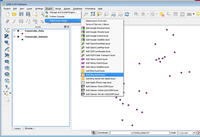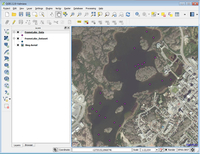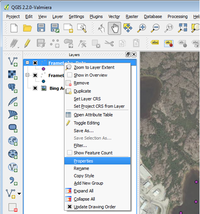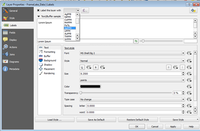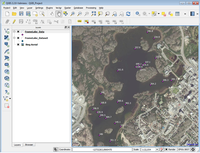Creating IDW and Spline Interpolation Maps Using QGIS
Performing IDW and Spline Interpolation Methods Using QGIS
Contents
Learning Outcomes of this Tutorial
Performing the following tasks within 'Quantum' GIS (QGIS): Importing point data files (shapefile, CSV); importing satellite imagery basemaps; labeling point data using attribute information; creating interpolated raster surfaces using IDW and spline interpolation methods (point shapefile being used for the model input), symbolizing interpolation raster surfaces, clipping raster surfaces with digitized polygons, and exporting the raster surfaces as a map.
Purpose
The purpose of this tutorial is to show users how to perform Inverse Distance Weight (IDW) and Spline interpolations, using several tools and plugins within QGIS, with the goal of creating interpolation maps. For the knowledge level of this tutorial, it is assumed that the user has some experience with GIS systems, whether it be from commercial products such as ESRI ArcMap or MapInfo or from open source packages such as QGIS, GRASS GIS, etc. However, this tutorial incorporates screen-shots for each step of the procedures and should be easy to follow along to.
Introduction
The purpose of this project was to explore toolsets and applications within different ‘open source’ geographic information systems (GIS) programs. The term ‘open source’ refers to the fact that all of these programs are free of charge to use, compared to more commonly known/taught (and user friendly) commercial packages such as ArcGis, which have costly license subscriptions. For a good listing of open course GIS programs available for download, visit the Open Source GIS page. This project was completed as a partial requirement (final course project) of the GEOM-4008 GIS course at Carleton University. For a complete list of other tutorials created for this course by students in the past, visit the CUOSG page.
Data
The data set being used for the purpose of this tutorial is a lake water geochemical dataset, consisting of 25 sampled locations on Frame Lake (Yellowknife, North West Territories), provided by the Patterson Research Group at Carleton University. This dataset has measured concentrations of major chemical elements (in PPM) and trace elements (PPM and PPB). The purpose of collecting this data is to map the concentration distributions of harmful elements, such as As, Pb, Hg and Cr within the lake, in order to determine which parts of the lake need the most remediation work done before trying to reintroduce fish populations into the lake.
However, this is unpublished scientific research data and therefore cannot be shared yet. However, any point data-set can be used for the purpose of this tutorial, so long as the points have a geographic location and an attribute that can be used for the interpolation (elevation, chemical concentration, etc). Some good sources of data for this tutorial include: Geobase, Geogratis, GIS Data Depot and Free GIS Data .
About QGIS
As described on their website, QGIS is a "A Free and Open Source Geographic Information System", and the latest version (v2.6) of the software is available for download on their Official Website. Like other GIS platforms it can be used to edit, create, visually represent, analyze and export a variety of geospatial data and it is licensed under the GNU General Public License. QGIS is an official project of the Open Source Geospatial Foundation (OSGeo). It runs on Linux, Unix, Mac OSX, Windows and Android and supports numerous vector, raster, and database formats and functionalities.
Acquiring QGIS (v.2.2) for this Tutorial
The slightly older version of QGIS that will be used for the purpose of this tutorial is v.2.2 which can be downloaded from this link link. Once you have downloaded the software from the QGIS website, follow the step-by-step installation instructions on your computer. With QGIS v.2.2 now installed on your computer and a suitable point dataset to be interpolated saved on your hard drive, you are now ready to start the tutorial.
Tutorial
Loading shapefile and CSV file data
- Launch QGIS (version 2.2) once you have installed it on your computer, and downloaded a suitable dataset to work with. There are two simple ways to import the point data into QGIS, depending on the type of data that you downloaded (shapefile, CSV file, excel spreadsheet). If your data is in the form of an excel spreadsheet (where the points have associated latitudes, longitudes and attribute data), save it as a comma-separated value (CSV) file before trying to import it into QGIS.
- To import a shapefile, click on the ‘Layer’ tab in the upper left hand corner of the screen, and select the ‘Add Vector Data’ tab.
- A window will then prompt you to navigate to your saved shapefile dataset on your hard drive. Afterwards click ‘open’ and you should see your point data on the main display.
- To import a CSV file, click on the ‘Layer’ tab in the upper left hand corner of the screen, and select the ‘Add Delimited Text Layer’ tab.
- A window will then prompt you to navigate to your saved CSV file on your hard drive. Assign a layer name for the output point-data, for this tutorial ‘FrameLake_Dataset’ was assigned. Select the ‘longitude’ field to represent the x-values and the ‘latitude’ field to represent the y-values. You may be also prompted to provide a map projection for the data (sometimes this is done automatically). If so, select a generic geographic projection (create hyperlink) such as WGS84 (hyperlink). Then click ‘ok’ to load the xy point data.
- The next step when loading a CSV file is exporting the loaded point data (from the previous step) to a shapefile. To do this in QGIS, right-click on the loaded point data layer and click ‘Save As’ tab.
- A window will then prompt you to pick the format of the file being saved, choose ‘ESRI Shapefile’. Browse for a location to save the shapefile on your hard drive, and for this tutorial, FrameLake_Data was assigned for the shapefile name. You will also need to specify a UTM projected coordinate system (hyperlink) for the output shapefile, in order to run interpolations on it in later steps. For North American datasets, one can use the NAD83 UTM projections, just be sure to select the correct UTM zone for the map area of your dataset. For the Yellowknife dataset used in this tutorial, NAD83-UTM zone 11 was chosen for the projection (browsed for NAD83(NSRS2007) / UTM zone 11N). And lastly, check the ‘Add saved file to map’ box. Then click ‘ok’.
Adding basemaps and labeling points
- Once you have successfully loaded your shapefile data, there are a few steps to perform in order to help you visualize your dataset, which includes loading a base map (used for creating a clipping layer in future steps) and labeling your sample points with attribute data (concentrations of harmful elements in this tutorial).
- To load a satellite image basemap in QGIS, you need to install a plugin to do this task. Click on the ‘Plugins’ tab and select ‘Manage and Install Plugins’.
- A window will appear that will show what plugins have been already installed, and what plugins are available for download. (Note. Plugins are the open source equivalent of tools within the Arc Toolbox in ESRI ArcMap). In the ‘Search’ bar, type ‘OpenLayers’ and then select the ‘OpenLayers Plugin’ from the list of available plugins. Then click ‘Install Plugin’.
- After the plugin has installed, close the plugin installation window. Then click on the Plugins tab again, hover over the OpenLayers Plugin, and select ‘Add Bing Aerial Layer’.
- The basemap will then appear on your map area. Drag the ‘Bing Aerial’ layer to the bottom of the map layer in the ‘Layers’ window. Then right-click on the ‘FrameLake_Data’ shapefile and select ‘Zoom to layer extent’. You will now notice that the lake water samples are now distributed around the arial extent of Frame Lake on the Bing Aerial layer.
- The next step will be to label the data points with the arsenic concentration measurement at each station. To do this, right-click on the FrameLake_Data shapefile and select ‘Properties’.
- The properties window will then appear. Click on the ‘Labels’ tab, check the ‘Label this layer with’ checkbox and then select ‘AsPPM’ from the dropdown box of attribute data. In this window you can specify the font, style, size, color, etc. of the labels. I changed the colour to white (to contrast the lake) and then clicked ‘apply’ and ‘ok’.
- Now the As concentrations are displayed for each point on the map and the points can be viewed in relation to a basemap. Having this information available will be helpful for the next portion of the tutorial which deals with performing the interpolations.

